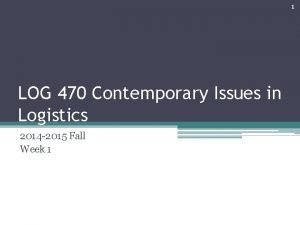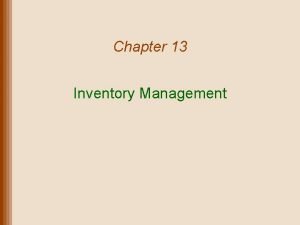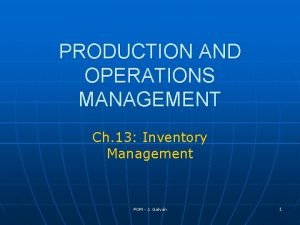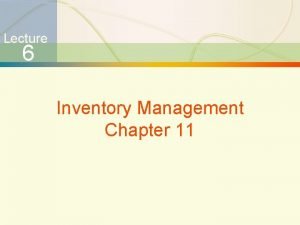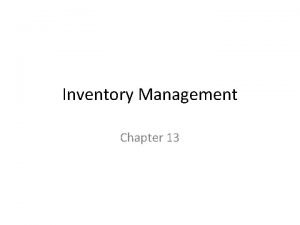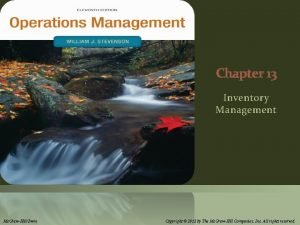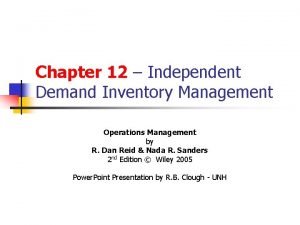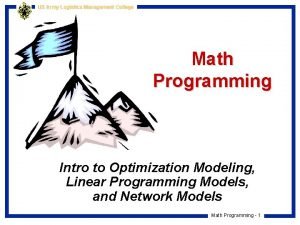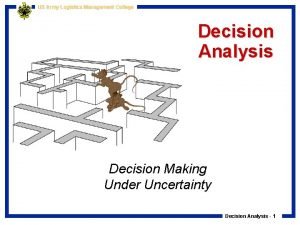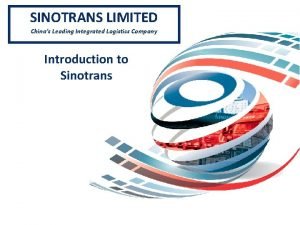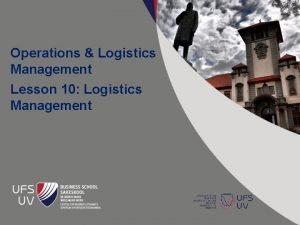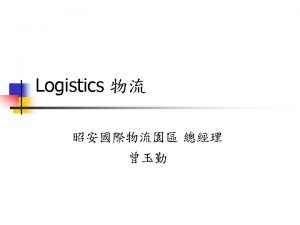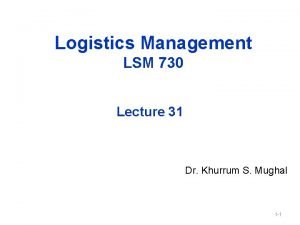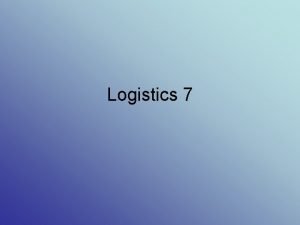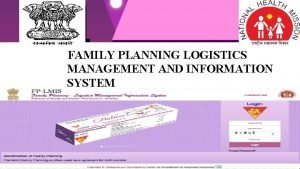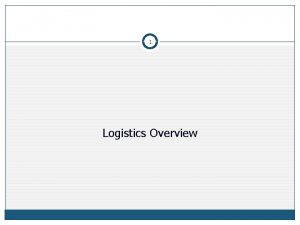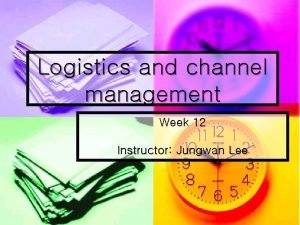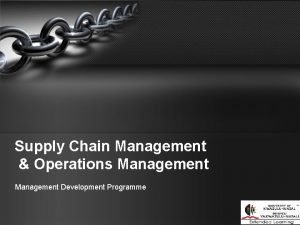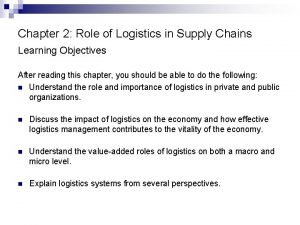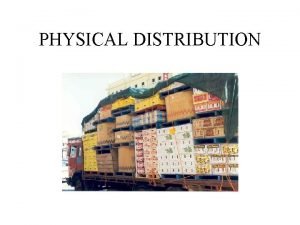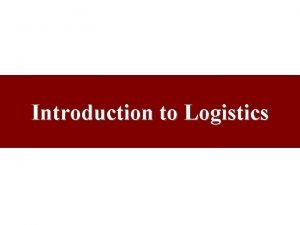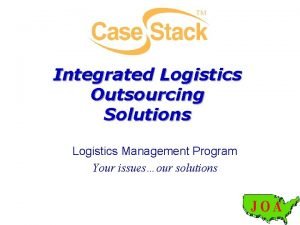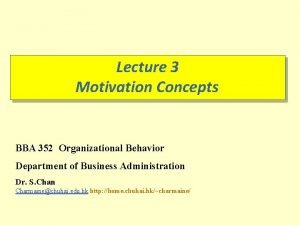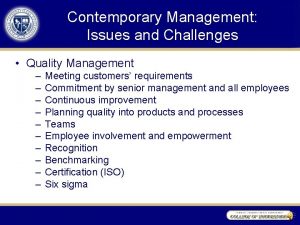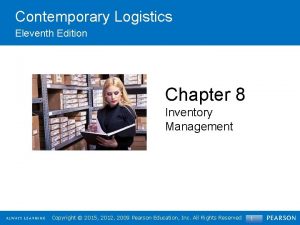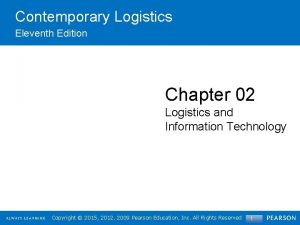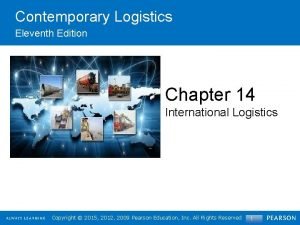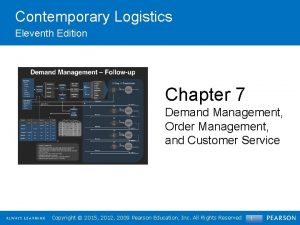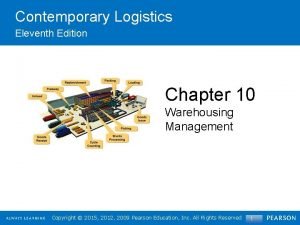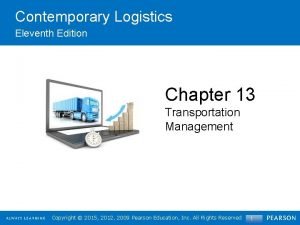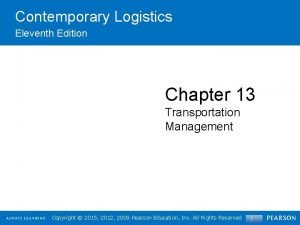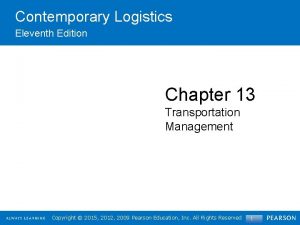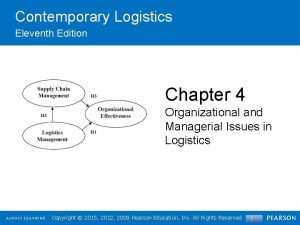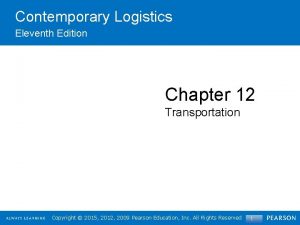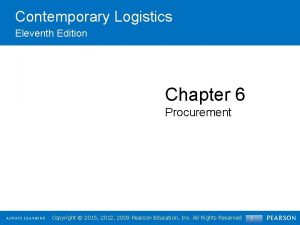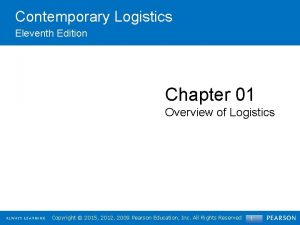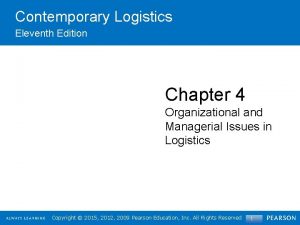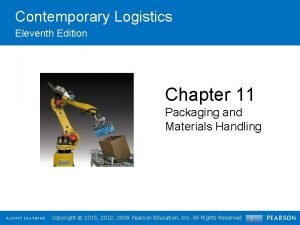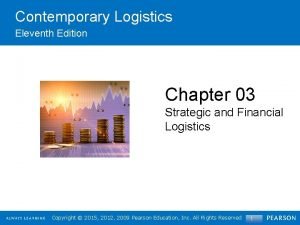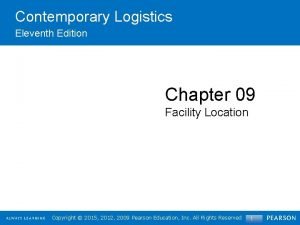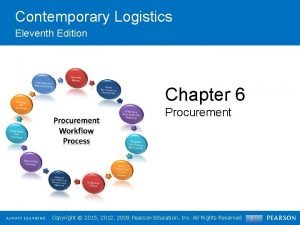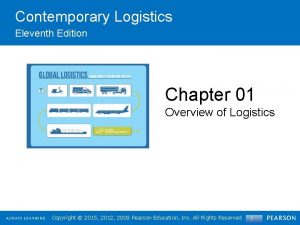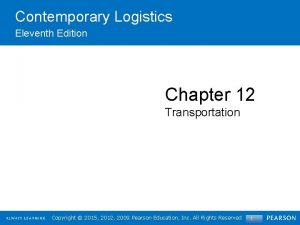Contemporary Logistics Eleventh Edition Chapter 8 Inventory Management










































- Slides: 42

Contemporary Logistics Eleventh Edition Chapter 8 Inventory Management Copyright©© 2015, 2012, 2009 Pearson. Education, Inc. All. Rights. Reserved Copyright 1

Learning Objectives • To learn about the ways that inventory can be classified • To discuss inventory costs and the trade-offs that exist among them • To identify when to order an how much to order, with a particular emphasis on the economic order quantity • To differentiate the various inventory flow patterns • To discuss special concerns with inventory management • To identify several contemporary approaches to managing inventory Copyright © 2015, 2012, 2009 Pearson Education, Inc. All Rights Reserved 2

Inventory Management Key Terms (1 of 3) • ABC analysis of inventory • Back order • Complementary products • Cycle (base) stock • Dead inventory (dead stock) • Economic order quantity (EOQ) • Fixed order interval system • Fixed order quantity system Copyright © 2015, 2012, 2009 Pearson Education, Inc. All Rights Reserved 3

Inventory Management Key Terms (2 of 3) • Inventory carrying (holding) costs • Inventory shrinkage • Inventory turnover • Just-in-time (JIT) approach • Lean manufacturing (lean) • Ordering costs • Pipeline (in-transit) stock Copyright © 2015, 2012, 2009 Pearson Education, Inc. All Rights Reserved 4

Inventory Management Key Terms (3 of 3) • Psychic stock • Reorder (trigger) point (ROP) • Safety (buffer) stock • Service parts logistics • Speculative stock • Stockout costs • Substitute products • Vendor-managed inventory (VMI) Copyright © 2015, 2012, 2009 Pearson Education, Inc. All Rights Reserved 5

Inventory Management (1 of 3) • Inventory refers to stocks of goods and materials that are maintained for many purposes, the most common being to satisfy normal demand patterns. Copyright © 2015, 2012, 2009 Pearson Education, Inc. All Rights Reserved 6

Inventory Management (2 of 3) • Inventory management • Inventory decisions drive other business activities like: • Warehousing • Transportation • Materials handling • Objectives can differ for different functional areas of an organization Copyright © 2015, 2012, 2009 Pearson Education, Inc. All Rights Reserved 7

Inventory Management (3 of 3) • Inventory management • Must consider inventory costs • Carrying costs • Ordering costs • Stockout costs Copyright © 2015, 2012, 2009 Pearson Education, Inc. All Rights Reserved 8

Inventory Classifications (1 of 2) • Cycle or base stock refers to inventory that is needed to satisfy normal demand during the course of an order cycle. • Safety or buffer stock refers to inventory that is held in addition to cycle stock to guard against uncertainty in demand or lead time. Copyright © 2015, 2012, 2009 Pearson Education, Inc. All Rights Reserved 9

Inventory Classifications (2 of 2) • Pipeline or in-transit stock is inventory that is en route between various fixed facilities in a logistics system such as a plant, warehouse, or store. • Speculative stock refers to inventory that is held for several reasons, including seasonal demand, projected price increases, and potential shortages of a product. • Psychic stock is inventory carried to stimulate demand (retail). Copyright © 2015, 2012, 2009 Pearson Education, Inc. All Rights Reserved 10

Inventory Costs (1 of 13) • Inventory costs in the twenty-first century represent approximately one-third of total logistics costs. • Inventory cost should factor into an organization’s inventory management policy. • Inventory costs include: • Carrying cost • Ordering cost • Stockout cost Copyright © 2015, 2012, 2009 Pearson Education, Inc. All Rights Reserved 11

Inventory Costs (2 of 13) • Inventory carrying (holding) costs • the costs associated with holding inventory. • In general expressed in percentage terms and this percentage is multiplied by the inventory’s value • Resulting number represents dollar value associated with holding the particular inventory Copyright © 2015, 2012, 2009 Pearson Education, Inc. All Rights Reserved 12

Inventory Costs (3 of 13) TABLE 8. 1 Magnitude of Inventory Costs Year Value of Business Inventory ($ billion) Inventory Carrying Cost (%) Inventory Carrying Cost ($ billion) Total Logistics Cost ($ billion) Inventory as a Percentage of Total Logistics Cost 2006 1, 859 24. 0 446 1, 305 34. 2 2007 2, 015 24. 1 485 1, 394 34. 8 2008 1, 963 21. 4 420 1, 344 31. 3 2009 1, 833 19. 3 353 1, 101 32. 1 2010 2, 018 19. 2 387 1, 204 32. 1 2011 2, 182 19. 1 478 1, 287 32. 1 2012 2, 269 19. 1 434 1, 331 32. 6 Source: 24 th Annual State of Logistics Report, 2013, prepared by Rosalyn Wilson for the Council of Supply Chain Management Professionals (www. cscmp. org). Copyright © 2015, 2012, 2009 Pearson Education, Inc. All Rights Reserved 13

Inventory Costs (4 of 13) TABLE 8. 2 Components of Inventory Carrying Cost Obsolescence costs Inventory shrinkage Storage costs Handling costs Insurance costs Taxes Interest costs Copyright © 2015, 2012, 2009 Pearson Education, Inc. All Rights Reserved 14

Inventory Costs (5 of 13) • Ordering costs refer to those costs associated with ordering inventory, such as order costs and setup costs. Copyright © 2015, 2012, 2009 Pearson Education, Inc. All Rights Reserved 15

Inventory Costs (6 of 13) • Examples of order costs include: • Costs of receiving an order (wages) • Conducting a credit check • Verifying inventory availability • Entering orders into the system • Preparing invoices • Receiving payment Copyright © 2015, 2012, 2009 Pearson Education, Inc. All Rights Reserved 16

Inventory Costs (7 of 13) • Trade-Off between Carrying and Ordering Costs • Costs respond in opposite ways to the number of orders or size of orders • An increase in the number of orders leads to higher order costs but lower carrying costs Copyright © 2015, 2012, 2009 Pearson Education, Inc. All Rights Reserved 17

Inventory Costs (8 of 13) • Calculations: • Ordering = # of orders per year x ordering cost per order Cost • Carrying = average inventory x carrying cost per unit Cost Copyright © 2015, 2012, 2009 Pearson Education, Inc. All Rights Reserved 18

Inventory Costs (9 of 13) • Stockout costs • an estimated cost or penalty for a stockout • involve an understanding of a customer’s reaction to a company being out of stock when a customer wants to buy an item Copyright © 2015, 2012, 2009 Pearson Education, Inc. All Rights Reserved 19

Inventory Costs (10 of 13) TABLE 8. 3 Determination of the Average Cost of a Stockout Alternative Loss Probability Average Cost 1. Brand-loyal customer $00. 00 . 10 $00. 00 2. Switches and comes back 37. 00 . 25 9. 25 1, 200. 00 . 65 780. 00 Empty 1. 00 $789. 25 3. Lost customer Average cost of a stockout Note: These are hypothetical figures for illustration. Copyright © 2015, 2012, 2009 Pearson Education, Inc. All Rights Reserved 20

Inventory Costs (11 of 13) • General Rules Regarding Stockout Costs • The higher the average cost of a stockout, the better it is for the company to hold some amount of inventory (safety stock) to protect against stockouts. • The higher the probability of a delayed sale, the lower the average stockout costs and the lower the inventory that needs to be held by a company. Copyright © 2015, 2012, 2009 Pearson Education, Inc. All Rights Reserved 21

Inventory Costs (12 of 13) • Trade-Off between Carrying and Stockout Costs • Costs move in opposite directions • Higher inventory levels (higher carrying costs) result in lower chances of a stockout (lower stockout costs) Copyright © 2015, 2012, 2009 Pearson Education, Inc. All Rights Reserved 22

Inventory Costs (13 of 13) TABLE 8. 4 Determination of Safety Stock Level Number of Units of Safety Stock Additional Safety Stock ($480 per Unit) 25% Annual Carrying Cost Total Value of Incremental Safety Stock Additional Orders Filled Stockout Costs Avoided 10 $4, 800 $1, 200 20 $8, 000. 00 20 9, 600 2, 400 1, 200 16 6, 400. 00 30 14, 400 3, 600 1, 200 12 4, 800. 00 40 19, 200 4, 800 1, 200 8 3, 200. 00 50 24, 000 6, 000 1, 200 6 2, 400. 00 60 28, 800 7, 200 1, 200 4 1, 600. 00 70 33, 600 8, 400 1, 200 3 1, 200. 00 Copyright © 2015, 2012, 2009 Pearson Education, Inc. All Rights Reserved 23

When to Order (1 of 3) • Key issue involves when product should be ordered • Can order a fixed amount of inventory (fixed order quantity system) • Or orders can be placed at fixed time intervals (fixed order interval system) Copyright © 2015, 2012, 2009 Pearson Education, Inc. All Rights Reserved 24

When to Order (2 of 3) • Reorder (trigger) point (ROP) • Level of inventory at which a replenishment order is placed • Necessary for efficient fixed order quantity system Copyright © 2015, 2012, 2009 Pearson Education, Inc. All Rights Reserved 25

When to Order (3 of 3) • Reorder Point (ROP) calculations: • ROP = DD x RC under certainty • ROP = (DD x RC) + SS under uncertainty • Where DD = daily demand • RC = length of replenishment cycle • SS = safety stock Copyright © 2015, 2012, 2009 Pearson Education, Inc. All Rights Reserved 26

How Much to Order (1 of 5) • Economic order quantity (EOQ) • Deals with calculating the proper order size with respect to two costs • Costs of carrying the inventory • Costs of ordering the inventory • Determines the point at which the sum of carrying costs and ordering costs is minimized, or the point at which carrying costs equal ordering costs Copyright © 2015, 2012, 2009 Pearson Education, Inc. All Rights Reserved 27

How Much to Order (2 of 5) • Copyright © 2015, 2012, 2009 Pearson Education, Inc. All Rights Reserved 28

How Much to Order (3 of 5) • Copyright © 2015, 2012, 2009 Pearson Education, Inc. All Rights Reserved 29

How Much to Order (4 of 5) FIGURE 8. 1 Determining EOQ by Use of a Graph Copyright © 2015, 2012, 2009 Pearson Education, Inc. All Rights Reserved 30

How Much to Order (5 of 5) TABLE 8. 5 EOQ Cost Calculations Number of Orders Per Year Order Size ($) Ordering Cost ($) Carrying Cost ($) Total Cost (sum of Ordering and Carrying Cost) ($) 1 1, 000 25 100 125 2 500 50 50 100 3 333 75 33 108 4 250 100 25 125 5 200 125 20 145 Copyright © 2015, 2012, 2009 Pearson Education, Inc. All Rights Reserved 31

Inventory Flows (1 of 2) FIGURE 8. 2 Inventory Flow Diagram Copyright © 2015, 2012, 2009 Pearson Education, Inc. All Rights Reserved 32

Inventory Flows (2 of 2) • Safety stock can prevent against two problem areas • Increased rate of demand • Longer-than-normal replenishment • When fixed order quantity system like EOQ is used, time between orders may vary • When reorder point is reached, fixed order quantity is ordered Copyright © 2015, 2012, 2009 Pearson Education, Inc. All Rights Reserved 33

Inventory Management: Special Concerns (1 of 3) • ABC Analysis of Inventory • recognizes that inventories are not of equal value to a firm • as such all inventory should not be managed in the same way • Dead inventory (dead stock) • is a fourth category, D, to ABC analysis where D stands for either “dogs” or dead inventory (dead stock) • refers to product for which there is no sales during a 12 month period. Copyright © 2015, 2012, 2009 Pearson Education, Inc. All Rights Reserved 34

Inventory Management: Special Concerns (2 of 3) • Copyright © 2015, 2012, 2009 Pearson Education, Inc. All Rights Reserved 35

Inventory Management: Special Concerns (3 of 3) • Substitute Products • products that can fill the same need or want as another product. Copyright © 2015, 2012, 2009 Pearson Education, Inc. All Rights Reserved 36

Contemporary Approaches to Managing Inventory (1 of 5) • Lean Manufacturing • Focuses on the elimination of waste and the increase of speed and flow • Identifies seven major sources of waste including inventory • Just-in-time (JIT) is one of the best known lean inventory practices Copyright © 2015, 2012, 2009 Pearson Education, Inc. All Rights Reserved 37

Contemporary Approaches to Managing Inventory (2 of 5) • Lean Manufacturing • Just-in-time (JIT) • Seeks to minimize inventory by reducing (or eliminating) safety stock while having the required amount of materials arrive at the production location at the exact time they are needed Copyright © 2015, 2012, 2009 Pearson Education, Inc. All Rights Reserved 38

Contemporary Approaches to Managing Inventory (3 of 5) • Service Parts Logistics • Involves designing a network of facilities to stock service parts: • Deciding upon inventory ordering policies • Stocking the required parts • Transporting parts from stocking facilities to customers Source: Mehmet Ferhat Candas and Erhat Kutanoglu, “Benefits of Considering Inventory in Service Parts Logistics Network Copyright © 2015, 2012, 2009 Pearson Education, Inc. All Rights Reserved 39

Contemporary Approaches to Managing Inventory (4 of 5) • Vendor-Managed Inventory (VMI) • Size and timing of replenishment orders are the responsibility of the manufacturer • Allows manufacturers to have access to a distributor’s or retailer’s sales and inventory data • Benefits include reduced inventories, fewer stockouts and improved customer retention Copyright © 2015, 2012, 2009 Pearson Education, Inc. All Rights Reserved 40

Contemporary Approaches to Managing Inventory (5 of 5) FIGURE 8. 4 Advertisement from a Parts Bank Service Source: Courtesy of Associated Distribution Logistics (ADL). Copyright © 2015, 2012, 2009 Pearson Education, Inc. All Rights Reserved 41

Copyright Notice All rights reserved. No part of this publication may be reproduced, stored in a retrieval system, or transmitted, in any form or by any means, electronic, mechanical, photocopying, recording, or otherwise, without the prior written permission of the publisher. Printed in the United States of America. Copyright © 2015, 2012, 2009 Pearson Education, Inc. All Rights Reserved 42
 Management eleventh edition
Management eleventh edition Management eleventh edition stephen p robbins
Management eleventh edition stephen p robbins Management eleventh edition
Management eleventh edition Management eleventh edition stephen p robbins
Management eleventh edition stephen p robbins Chadha committee
Chadha committee Eleventh 5 year plan
Eleventh 5 year plan 11th five year plan
11th five year plan For his eleventh birthday elvis presley
For his eleventh birthday elvis presley Contemporary issues in logistics
Contemporary issues in logistics Chapter 12 inventory management
Chapter 12 inventory management Using mis (10th edition) 10th edition
Using mis (10th edition) 10th edition Using mis (10th edition) 10th edition
Using mis (10th edition) 10th edition Chapter 13 inventory management problems and solutions
Chapter 13 inventory management problems and solutions Chapter 13 inventory management problems and solutions
Chapter 13 inventory management problems and solutions Chapter 13 inventory management
Chapter 13 inventory management Chapter 13 inventory management
Chapter 13 inventory management Chapter 13 inventory management
Chapter 13 inventory management Annual ordering cost formula
Annual ordering cost formula Principles of management (collection) stephen p. robbins
Principles of management (collection) stephen p. robbins Army logistics management college
Army logistics management college Us army logistics management college
Us army logistics management college Performance cycle uncertainty
Performance cycle uncertainty Sinotrans air huawei
Sinotrans air huawei Logistics management introduction
Logistics management introduction Council of logistics management 1998
Council of logistics management 1998 Logistics strategy triangle
Logistics strategy triangle Objectives of logistics management
Objectives of logistics management Family planning logistics management information system
Family planning logistics management information system Ecrm definition
Ecrm definition Objectives of logistics management
Objectives of logistics management What is logistics management
What is logistics management Logistics and channel management
Logistics and channel management Ford mp&l
Ford mp&l Supply chain development programme
Supply chain development programme Role of logistics management
Role of logistics management Components of physical distribution
Components of physical distribution What is logistics
What is logistics Integrated logistics management
Integrated logistics management Global logistics and supply chain strategy
Global logistics and supply chain strategy Contemporary management practices
Contemporary management practices Contemporary theory of management
Contemporary theory of management Contemporary theory of management
Contemporary theory of management Contemporary management issues and challenges
Contemporary management issues and challenges








